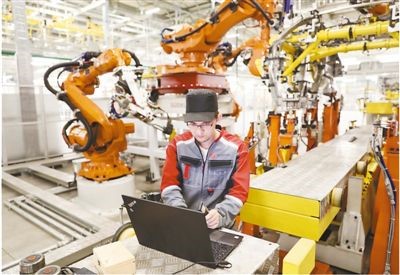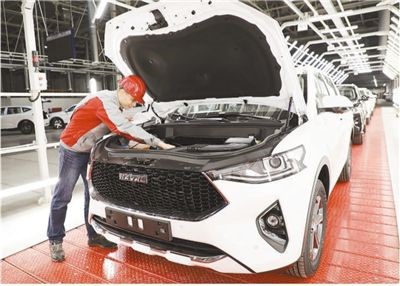Chinese automaker to go for production in Russia

A local worker debugs the robot’s trajectory at a workshop of the Haval Factory in Russia’s Tula Region. (Bai Yang, People’s Daily)
Tula Region, adjacent to the Russian capital Moscow, is not only the hometown of the eminent writer Leo Tolstoy, but also famous for its durable military products and sweet and delicious pies.
Now, China’s largest investment project in Russia’s manufacturing sector, Haval Russia Automotive Manufacturing Co., Ltd. (hereinafter referred to as “Haval Factory”), has been built in Tula.
At present, the first phase of the project has been completed and will soon be put into operation, with an estimated annual output of 80,000 automobiles and thousands of job opportunities to be created. The factory’s local staff said that Haval SUV will become a new name card of the city.
The national flags of China and Russia flying in the wind, the eye-catching logo of “Havel” and the huge plant make up an impressive scene at the Uzlovaya Industrial Park, which is more than 30 kilometers away from the capital of Tula.
Dong Xueyong, director of the manufacturing department of the Haval Factory, said that the factory, covering an area of more than 200 hectares, is the largest investment project between the two countries in the manufacturing sector.
While going overseas, China’s Great Wall Motor Company Limited (GWM), a major SUV maker and parent company of Haval, reached an intent of cooperation with the Tula Region Government that enjoys advantageous geographical location.

A work tests a Haval car produced during trial operation of the company. (Yin Xinyu, People’s Daily)
After the two sides signed an investment agreement in May 2014 witnessed by the heads of state of China and Russia, the project entered rapid development.
According to the agreement, GWM would invest and build the Haval Factory, which mainly produces Haval SUVs, and would invest $500 million in the first phase of the project.
Zhang Junxue, vice president of GWM and general manager of the Haval Factory, said that all production stages including pressing, welding, painting and integrated assembly are finished at the factory. It indicates GWM’s resolution to take root in the region.
Sergey Artemyev, head of the investment department of Tula Region Development Corporation, said the factory, the largest foreign investment project to date in Tula, will bring thousands of job opportunities and drive up tax revenue, and therefore they will spare no efforts to support it.
Local media commented that the factory would allow Russian people an access to more cost-effective vehicles in the future.
The local government has issued a package of preferential policies for the factory including tax and fee reduction and exemption, and provided one-stop customs service. Alexey Dyumin, governor of Tula Region, supervised the project in person.
At the peak time of the factory construction, all of the 300 engineering machineries of the region were operating at the project site. So far, many of the infrastructure construction projects have been completed.
At a recent rollout ceremony, Dyumin tested a vehicle that was produced during the trail operation. He gave a high comment on the performance of the car, saying that he would be the first customer when the model hits the market.
At present, the factory hires over 800 employees and 90 percent of them are locals. Dong introduced that as Tula had no auto industry before, the factory has sent staffs on key positions, such as workshop leaders to China for training. And those who acquired professional skills in China would pass on their knowledge to the others when they went back home. This mode has worked very well.
“The workers are studying very hard and are vigorous in the work, which has facilitated the smooth operation of the factory,” Dong said.
Olga Belevtseva, vice mayor of Uzlovaya, where the Haval Factory is located, said Haval not only employed a large number of local workers, but also renovated local school buildings, doing a lot to fulfill its social responsibility and provide public welfare benefits.
“All our citizens are in high spirits as the construction of the factory progresses day by day. The factory will bring encouraging changes to our lives and guarantee the prosperity and development of our city,” said the vice mayor.
Tula Region enjoys strong industrial strength, but it also needs to upgrade such industries as chemical fertilizer manufacturing, chemical engineering, and traditional handicrafts.
The Tula Region Government hopes that the construction of the Haval factory will drive the development of its automobile industry. Now, the government is actively participating in various automobile exhibitions and engaging in cooperation discussions with automobile companies. The automotive industry will be Tula’s new growth point of fiscal revenue, said Artemyev.


 +86-13460933678
+86-13460933678